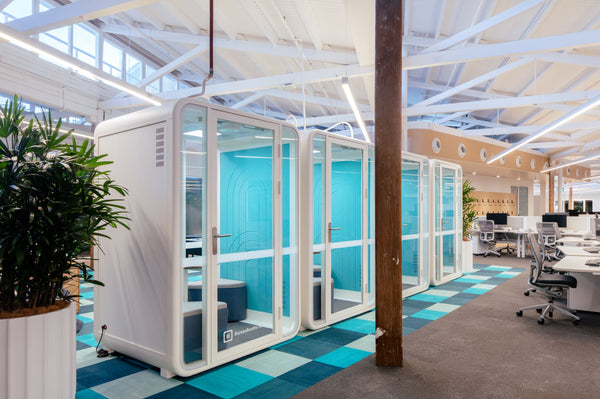Neurodiversity is the difference between the way humans function and describes the optimal conditions for each individual. Designing office spaces that maximises each person’s ability should be at the heart of each office fit-out. Here are four ways to help ensure that your office is inclusive and encourages neurodiversity.

- Create sensory destinations within your workplace
A great way to celebrate and support neurodiversity is to create a range of sensory destinations within the office space. A sensory destination can be a small custom space in your workplace which is characterised by a change in senses. This grants your employees the choice in deciding what space in the office is the best for them, whether that person functions better with background noise, or silence, a high energetic collaborative space, or a solo-work mood room.
- Allow for adjustable lights, colour, and sound
Many neurodiverse individuals have an increased sensitivity to harsh lighting and sounds which can be overwhelming and reduce their productivity. Natural light has been found to be the most widely liked form of lighting. While not all office spaces have access to skylights or windows, adjustable LEDs are a great choice to change both brightness and colour to suit the individuals preference. Sound is just as important to manage throughout the office as many individuals find external noise distracting. Including designated meeting spaces and manipulating the acoustics in the office with sound panels, can help maintain a suitable noise level.

- Ergonomics and comfort
Uncomfortable or rough office furnishings can repel employees particularly those with tactile sensitivity. Having a large range of functional options such as standing desks, pacing areas, and break out spaces as well comfort options such as comfortable couches and chairs can increase employee effectiveness by reducing tactile discomfort.
- Prioritise well ventilated spaces
Neurogenetic sensitivity to smell is known as hypersomnia and can induce migraines and other forms of discomfort from any strong smells such as food or perfume. Having good ventilation is imperative for any strong smells to be filtered out. Good options for this are to increase the office plant life, maintaining a ventilation cycle through windows, and using fragrance free cleaners.
Optimise your space with Bureau
Bureau booths are a functional and cost-effective way to promote and support neurodiversity in your office. Bureau Booths are an excellent low stimulation environment for neurodivergent people to regulate themselves, a sensory sanctuary where the individual can take a break from sensory overload. From meeting rooms to individual workstations, each booth is highly customisable and includes:
- Acoustic panelling and double-glazed windows, for major sound reduction, an ideal quiet break out room for your employees.
- Ergonomically designed furniture, that prioritises comfort and employee satisfaction.
- Market leading ventilation, that cycles all the air in less than three minutes.
- Adjustable mood lighting, to reflect the sensory needs and preferences of the user.
- Premium materials to ensure longevity and style, such as aluminium frames, carbon polymer with woven PET lining, and safety glass.

In addition, Bureau Booths offer a range of customisation options that make them ideal for any environment, industry, or design. These include:
- Graphics and skins (colours, patterns, logos, whiteboard exteriors)
- Custom sizes and dimensions
- Fabrics and materials (acoustic panels, carpet, furniture)
- Custom lighting
- Smart locks
- Furniture configuration within the booth
- Wheelchair accessibility
At Bureau Booths we have lots of experience working with companies to design their perfect Booth and customising to seamlessly fit any office space. Inquire at: team@bureaubooths.com for any questions or comments you might have.

